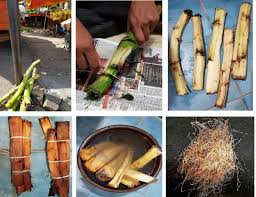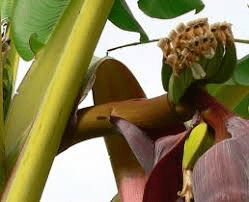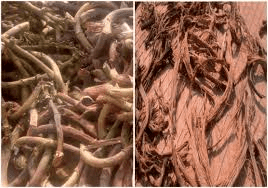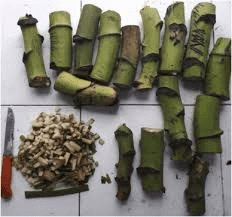The plantain peduncle, also known as the plantain stalk or stem, is the central support structure from which plantains grow. It is a key part of the plantain plant’s reproductive system. The peduncle originates from the corm, a swollen underground stem, and grows upward, becoming the main axis of the plant. This structure is responsible for supporting the inflorescence, the cluster of flowers that eventually develop into fruit.
The plantain peduncle is sturdy and fibrous, capable of bearing the weight of the large, heavy bunches of plantains. It can grow up to several meters in length and varies in thickness. The surface of the peduncle is often covered with leaf sheaths, which provide additional support and protection. These sheaths are green when young and turn brown as they age.
The internal structure of the peduncle consists of vascular bundles that transport water, nutrients, and sugars between the roots and the developing fruits. These bundles are surrounded by parenchyma cells, which store nutrients and provide structural support. The vascular system of the peduncle is crucial for the growth and development of the plantain fruits, ensuring they receive adequate nourishment.
The development of the peduncle is a fascinating process. It begins with the initiation of the floral meristem, a specialized tissue that gives rise to the flowers. This meristem differentiates into individual flower buds, which are arranged in a spiral pattern along the length of the peduncle. Each flower bud develops into a plantain, with the oldest flowers located at the base of the peduncle and the youngest at the tip.
As the flowers mature, they undergo fertilization, leading to the formation of fruits. The plantain fruits grow in clusters, known as hands, along the peduncle. Each hand consists of several plantains, which develop from individual flowers. The number of hands per peduncle can vary, but it is not uncommon for a single peduncle to support 10 to 20 hands, each containing multiple fruits.
The plantain peduncle continues to play a vital role even after the fruits have matured. It serves as a conduit for the translocation of nutrients and sugars, which are essential for the ripening process. During ripening, the peduncle facilitates the breakdown of starches into sugars, resulting in the sweet taste of ripe plantains.
In addition to its functional roles, the plantain peduncle has economic and ecological significance. It is used in various traditional practices and industries. In some cultures, the fibers from the peduncle are extracted and used for making ropes, mats, and other woven products. The peduncle is also utilized as animal feed and as an organic mulch in agricultural practices.
Ecologically, the plantain peduncle contributes to the overall health of the plantain plant. It provides structural support, ensuring that the plant remains upright and stable. This stability is crucial for the plant’s ability to capture sunlight for photosynthesis and withstand environmental stresses such as strong winds and heavy rains.
The plantain peduncle is a vital part of the plantain plant’s anatomy and reproductive system. It supports the growth and development of the fruits, facilitates nutrient transport, and has various practical applications. Understanding the structure and function of the plantain peduncle provides valuable insights into the biology and cultivation of this important crop.
The Economic Importance and Uses of Plantain Peduncle

1. Animal Feed: Plantain peduncle can be processed into feed for livestock. For example, it can be chopped and mixed with other feed ingredients to provide nutrition for cattle, goats, and poultry.
2. Organic Fertilizer: The fibrous material in the plantain peduncle decomposes easily and can be used as organic fertilizer. Farmers often compost the peduncles to improve soil fertility and structure.
3. Biofuel Production: Plantain peduncles can be used to produce bioethanol, a renewable energy source. This involves fermentation and distillation processes to convert the biomass into ethanol fuel.
4. Handicrafts: The fibers from plantain peduncles are used in making various handicrafts such as baskets, mats, and ropes. This provides income for artisans in rural areas.
5. Paper Production: Plantain peduncle fibers can be processed into paper. The cellulose content in the peduncle makes it suitable for this purpose, providing an eco-friendly alternative to wood-based paper.
6. Medicinal Uses: In traditional medicine, plantain peduncles are used to treat various ailments. For example, extracts are used to alleviate stomach issues and reduce inflammation.
7. Construction Material: The strong fibers of the plantain peduncle can be used in the construction industry. They are used to reinforce building materials like bricks and cement blocks.
8. Mushroom Cultivation: The peduncles serve as a substrate for mushroom cultivation. They provide the necessary nutrients and environment for mushroom growth.
9. Animal Bedding: Plantain peduncle fibers are used as bedding material for animals. They are absorbent and provide a comfortable resting place for livestock.
10. Biodegradable Packaging: Plantain peduncle fibers can be used to create biodegradable packaging materials, reducing reliance on plastic.
11. Textile Industry: The fibers can be spun into threads and used in the textile industry to make eco-friendly fabrics.
12. Biochar Production: When plantain peduncles are subjected to pyrolysis, they produce biochar, which is used to enhance soil fertility and sequester carbon.
13. Water Filtration: The fibrous material can be used in water filtration systems to remove impurities, providing clean drinking water in rural areas.
14. Vermiculture: Plantain peduncles are used in vermiculture to feed earthworms, which in turn produce high-quality vermicompost.
15. Fodder for Ruminants: In areas where forage is scarce, plantain peduncles serve as an alternative fodder for ruminants like cows and sheep.
16. Craft Paper: The peduncle fibers are used to make craft paper, which is used for art projects and decorative purposes.
17. Eco-friendly Disposables: Plantain peduncle fibers are used to manufacture disposable plates, cups, and cutlery that are biodegradable.
18. Fish Feed: The peduncles are processed into fish feed, providing an affordable and nutritious option for fish farmers.
Read Also: How to know the Best Specie of Fish to Raise
The Products and By-products That Can Be Derived From Plantain Peduncle

1. Fibers: Plantain peduncle fibers are extracted and used in making textiles, ropes, and handicrafts.
2. Bioethanol: The peduncle is fermented and distilled to produce bioethanol, a renewable fuel.
3. Organic Fertilizer: Composting the peduncle results in organic fertilizer for agriculture.
4. Paper: The cellulose content in the peduncle is used to make paper.
5. Biochar: Pyrolysis of the peduncle produces biochar, which is used for soil enhancement and carbon sequestration.
6. Animal Feed: Processed plantain peduncle is used as feed for livestock and fish.
7. Handicrafts: The fibers are used to create various handicrafts like baskets and mats.
8. Mushroom Substrate: The peduncle serves as a substrate for growing mushrooms.
9. Biodegradable Packaging: Fibers are used to make eco-friendly packaging materials.
10. Construction Material: The fibers reinforce building materials like bricks and cement blocks.
11. Water Filters: The fibrous material is used in water filtration systems.
12. Vermicompost: The peduncle is used in vermiculture to feed earthworms for producing vermicompost.
13. Animal Bedding: The fibers provide comfortable bedding for livestock.
14. Craft Paper: Fibers are used to make decorative craft paper.
15. Eco-friendly Disposables: The peduncle is used to manufacture biodegradable plates, cups, and cutlery.
16. Textiles: Fibers are spun into threads for making eco-friendly fabrics.
17. Medicinal Extracts: Extracts from the peduncle are used in traditional medicine to treat various ailments.
Read Also: The Most Lucrative between Production of Fish Fingerlings or Raising them to Table Size
Frequently Asked Questions (FAQ’s) About Plantain Peduncle

1. What is a plantain peduncle? The plantain peduncle is the stalk that supports the plantain fruit cluster, connecting it to the main plant.
2. How can plantain peduncles be used in agriculture? They can be composted into organic fertilizer to improve soil fertility.
3. Are plantain peduncles edible? While the fruit is edible, the peduncle itself is typically not consumed but used in other applications like animal feed and composting.
4. How are plantain peduncles processed into bioethanol? They are fermented and distilled to produce ethanol fuel.
5. Can plantain peduncles be used in construction? Yes, their fibers are used to reinforce building materials like bricks and cement blocks.
6. What handicrafts can be made from plantain peduncles? Items like baskets, mats, and ropes can be crafted from the fibers.
7. How do plantain peduncles benefit mushroom cultivation? They provide a nutrient-rich substrate for mushroom growth.
8. Are plantain peduncles used in traditional medicine? Yes, extracts from the peduncle are used to treat ailments such as stomach issues and inflammation.
9. How do plantain peduncles contribute to environmental sustainability? They are used to make biodegradable packaging, reducing plastic waste.
10. Can plantain peduncles be used as animal feed? Yes, they can be processed and mixed with other ingredients to provide nutrition for livestock and fish.
Read Also: Succulent Plants: A Guide to Growing and Caring for These Unique Plants

